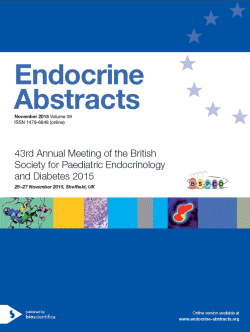Searchable abstracts of presentations at key conferences in endocrinology

Society for Endocrinology BES 2015
Edinburgh,
UK
02 Nov 2015 - 04 Nov 2015

2-4 November 2015, Edinburgh, UK
Further information
Symposia
Endocrinology meets the environment
ea0038s1.1 | Endocrinology meets the environment | SFEBES2015
Later life consequences of maternal vitamin D deficiency – MAVIDOS study
Low concentrations of 25-hydroxyvitamin D, the major circulating storage form, are common in the general population. Over recent decades, there has been increasing evidence for a role of vitamin D in disease pathogenesis far beyond the musculoskeletal system. Thus, many studies have investigated whether low levels of circulating 25-hydroxyvitamin D have a detrimental effect on pregnancy outcomes, for both mother and offspring, and whether supplementation with vitamin D might a...
ea0038s1.2 | Endocrinology meets the environment | SFEBES2015
Iodine deficiency
Iodine is an essential component of the thyroid hormones thyroxine (T4) and triiodothyronine (T3) which play a crucial role in brain and neurological development. The ideal dietary allowance of iodine recommended by World Health Organisation (WHO) is 150 μg of iodine per day which increases to 200250 μg/day in pregnancy. Severe iodine deficiency may be associated with impairment in the psycho-neurological outcome in the progeny because bot...
ea0038s1.3 | Endocrinology meets the environment | SFEBES2015
Environmental influences on autoimmunity
Autoimmune endocrine diseases are seen as multifactorial complex diseases in which immune reactions against self-antigens from endocrine glands develop against a particular genetic background facilitated by exposure to environmental factors. A number of these factors have been identified, and most interestingly they can be protective for one disease but a risk for another disease. Much has still to be learned about gene-environment interactions. As an example we wi...



